Krain |
|
|
|
| Übersicht – Contents: | |
Krain |
|
|
|
| Übersicht – Contents: | |
Flaggen – Flags: |
|
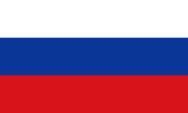 |
1848–1919, Landesflagge (Landesfarben) – Flag of the country (colours), Seitenverhältnis – ratio = 2:3, Quelle/Source nach/by: Wikipedia (EN) |
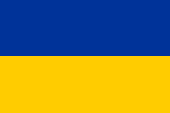 |
bis/to 1848, Landesflagge (Landesfarben) – Flag of the country (colours), Seitenverhältnis – ratio = 2:3, Quelle/Source nach/by: Wikipedia (D) |
|
|
|
Bedeutung/Ursprung der Flagge – Meaning/Origin of the Flag: |
|
| Das Land hatte, wie alle Kronländer der österreichischen Krone, seine eigenen, sogenannten Landesfarben, die unter anderem auf horizontal getreiften zwei- oder dreistreifigen Flaggen gezeigt wurden. Die Landesfarben waren sehr oft dem jeweiligen Wappen des Kronlandes entnommen oder wurden duch eine weitere, nicht im Wappen enthaltene Farbe ergänzt, oder sie gingen auf ältere Modelle des Landeswappens zurück (z.B. Krain). Offiziell waren die Landesfarben aber nie geregelt oder festgelegt worden, so dass deren Reihenfolge in der Praxis of variierte oder die Farben gar an sich abwichen. Der österreichische Heraldiker Hugo Gerard Ströhl (1851–1919) hat sich wohl als erster des Themas angenommen und wahrscheinlich um das Jahr 1890 herum die Landesfarben auf den Flaggen bei den jeweiligen Landesbehörden abgefragt und zusammengestellt. |
The country had – like all the other crown lands of the Austrian
crown – its own colours (Landesfarben), which were used amongst others on
horizontally two- or three-striped flags. The colours (Landesfarben) were very often taken from the respective coat of arms of the country or were supplemented by another colour, which not appears in the coat of arms, or they went back to older models of the coat of arms (e.g. Carniola). Officially, the colours had never been regulated or stipulated, so that their sequence varied in practice or even the colors deviated. The Austrian heraldist Hugo Gerard Ströhl (1851–1919) was probably the first to take care of it and asked for the colors (Landesfarben) on the flags at the respective state authorities around 1890 and compiled them. |
| Das Herzogtum Krain verwendete als Landesfarben ursprünglich die Farben Blau und Gold. Die Farben stammen vom Wappen Krains aus dem 16. Jahrhundert. | The Duchy of Carniola used as colours of the country initially the colours blue and gold. The colours descend from the coat of arms of Carniola from the 16th century. |
| Im Jahre 1836 stellte Kaiser Ferdinand I. von Österreich das Landeswappen in seiner ursprünglichen Färbung mit dem silbernen Schild wieder her. Die Landesfarben verblieben jedoch unverändert in Blau und Gold. | In 1836, Emperor Ferdinand I. of Austria restored the country's coat of arms in its original colours with the silvery shield. The colors of the country remained unchanged in blue and gold. |
| Auf Initative des Kommandanten der Nationalgarde von Laibach, des Slowenischen Vereins und mehrerer krainischer Reichstagsabgeordenten entstanden 1848 neue Landesfarben. Auf der Flagge waren sie als drei horizontale Streifen in Weiß, Blau und Rot angeordnet. Das Innenministerium des Kaiserreichs Österreich empfahl am 23.09.1848 (Eröffnung, Aktenzeichen Z. 2778) die Farben anzunehmen, jedoch nur, wenn Wappen und Siegel unverändert bleiben und keinerlei andere Rechte daraus abgeleitet werden. Das illyrische Landespräsidium setzte die Entscheidung am 29.09.1848 ger Gesetz um (Aktenzeichen Z. 241/P), was im Amtsblatt "Laibacher Zeitung" vom 03.10.1848, Seite 599 bekannt gegeben wurde. Einerseits nahmen die Krainer damit die Farben des Herzogtums Krain aus der Zeit vor 1463 als die ihren an, andererseits nahmen sie eine Flagge in den "Panslawische Farben" an – eine exakte Kopie der russischen Flagge. Krain ist das Kernland des heutigen Slowenien, das diese Farben noch immer nutzt. | On the initiative of the commander of the National Guard in Laibach (Ljubljana), of the Slovenian Association and of several Carniolan Reichstag deputies, new national colors were created in 1848. On the flag they were arranged as three horizontal stripes in white, blue and red. The Ministry of the Interior of the Austrian Empire recommended on 23rd of September in 1848 (petition, file number Z. 2778), that the colors have to be adopted, but only if the coat of arms and the seal remained unchanged and no other rights were derived from that. The Illyrian State Presidium implemented the decision on 29th of September in 1848 by law (file number Z. 241/P), which was announced in the official gazette "Laibacher Zeitung" from 3rd of October in 1848, page 599. On the one hand, the Carniolans adopted the colors of the Duchy of Carniola from the time before 1463 as theirs, on the other hand they adopted a flag in the "Pan-Slavic Colours" – an exact copy of the Russian flag. Carniola is the heartland of today's Slovenia, which uses these colors until today. |
| Quelle/Source: nach/by: Wikipedia (D), Wikipedia (EN), Österreichisch-Ungarische Wappenrolle | |
Wappen – Coat of Arms: |
|
 |
bis/to 1463, Wappenschild von Krain – blazon of Carniola, Quelle/Source: nach/by Wikipedia (D) |
 |
1463–1836, Wappenschild von Krain – blazon of Carniola, Quelle/Source: nach/by Wikipedia (D) |
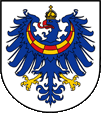 |
1836–1919, Wappenschild von Krain – blazon of Carniola, Quelle/Source: nach/by Wikipedia (EN) |
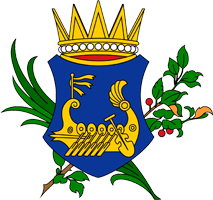 |
1816–1849, Krain gehört zum Habsburgischen Königreich Illyrien – Carniola belongs to the Habsburg Kingdom of Illyria, Quelle/Source nach/by: Ströhl, Wappenrolle Österreich-Ungarns, 1890, via Wikipedia (D) |
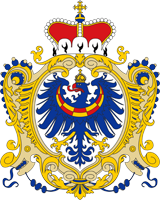 |
ca.1890–1918, Wappen Herzogtum Krain – coat of arms of the Duchy of Carniola, Quelle/Source nach/by: Ströhl, Wappenrolle Österreich-Ungarns, 1890, via Wikipedia (D) |
Bedeutung/Ursprung des Wappens – Meaning/Origin of the Coat of Arms: |
|
| Das Wappen Krains zeigte ursprünglich einen blauen Adler mit roter Bewehrung auf silbernem Schild, belegt mit einem zehnmal in Rot und Silber geschachten Brustmond (auch Spange genannt). | The coat of arms of Carniola showed originally a blue eagle with red arms on a silvery shield, on it a ten-times in red and gold checkered crescent (also called barrette). |
| Im Jahre 1463 wurde das Wappen auf Veranlassung von Kaiser Friedrich III. geändert. Die Krainer standen Kaiser Friedrich III. im Jahre 1462 bei, als er in der Wiener Burg von seinem Bruder Albrecht VI. belagert wurde. Zum Dank besserte er das Wappen des Herzogtums. Das Wappen Krains zeigte nun einen blauen Adler mit roter Bewehrung auf goldenem Schild. Die Farben des Brustmonds wechselten zu Rot und Gold und der Adler trägt eine Krone. | In 1463, the
coat of arms was changed at the behest of Emperor Frederick III. The
Carniolans helped Emperor Friedrich III. in 1462 when he was besieged in
Vienna Castle by his brother Albrecht VI. In thanks, he improved the coat of arms of the duchy. The coat of arms of Carniola now showed a blue eagle with red arms on a golden shield. The colors of the checkered crescent changed to red and gold and the eagle wears a crown. |
| Im Jahre 1836 stellte Kaiser Ferdinand I. von Österreich das Landeswappen in seiner ursprünglichen Färbung mit dem silbernen Schild wieder her. Als Habsburgisches Kronland trug das Wappen einen Fürstenhut. | In 1836, Emperor Ferdinand I. of Austria restored the country's coat of arms in its original colours with the silvery shield. As an Habsburg crown land the coat of arms showed above a princely hat. |
| Quelle/Source: nach/by: Wikipedia (D), Wikipedia (EN), Österreichisch-Ungarische Wappenrolle | |
|
Lesen Sie hier:
Hintergründe, Geschichte und Fakten zum Thema "Der Adler in der Heraldik"; Ausführungen, Varianten und Entwicklung. |
 |
| die Kronländer Österreich-Ungarns – Crown Lands of Austria-Hungary: |
|
| Quelle/Source: Volker Preuß |
| geschichtliche Landkarten – historical Maps: | |
|
|
|
|
|
|
| Landkarte/Map: Volker Preuß | |
Zahlen und Fakten – Numbers and Facts: |
|
|
|
|
|
|
|
|
|
|
|
|
|
|
|
|
|
|
Geschichte: |
| ca. 15
n.Chr. · die Eroberung des heutigen Krain durch das
Römische Reich ist abgeschlossen,
zur Provinz Pannonia Superior 395 · bei der Teilung des Römischen Reiches kommt das heutige Krain an das Weströmische Reich 476–489 · Krain gehört zum Reich des Odoaker 489–553 · Krain gehört zum Reich der Ostgoten 6. Jhd. · Besiedlung durch Slawische Stämme 569–598 · Eroberung durch die Awaren ca. 800 · das heutige Krain wird durch das Frankenreich der Karolinger unterworfen, Bildung der "Mark Krain", Verwaltung durch den Markgrafen und Herzog von Friaul 934 · die Mark Krain kommt zu Bayern 976 · Krain kommt zum Herzogtum Kärnten 1394 · Krain (einschl. Istrien) wird selbstständiges Habsburgisches Herzogtum 1797–1809 · Französische Revolutionskriege: ein Teil Österreichs (Steiermark) wird 1797 von den Franzosen besetzt 1809 · Friede von Wien, Österreich verliert Salzburg, das Innviertel, Westgalizien und Teile von Ostgalizien und tritt Istrien, Triest, Görz, Krain, Kärnten, Kroatien, und Dalmatien an Frankreich ab, die 1810 zu den französischen "Illyrischen Provinzen" zusammengefasst werden 1813 · Österreich erklärt Frankreich (Napoléon) den Krieg 1814/1815 · Wiener Kongress, Neuordnung Europas nach der Ära Napoléon, das Kaiserreich Österreich (Haus Habsburg) erhält die 1809 verlorenen Gebiete zurück, sie werden zum Habsburgischen Königreich Illyrien zusammengefasst, Krain wird Teil des Habsburgischen Königreichs Illyrien, Dalmatien und Kroatien werden wieder an Ungarn (unter den Habsburgern, Teil des Kaiserreichs Österreich) angeschlossen 1848/1849 · Revolution in Wien, Bürgerkrieg zwischen Ungarn und Kroaten, Aufstände in Prag, Mailand und Venedig, daraufhin dankt Kaiser Ferdinand I. ab und Franz Joseph I. von Habsburg wird neuer Kaiser, die Aufstände werden niedergeschlagen und er erlässt eine neue Verfassung: die Titular-Erblande der Habsburger im Kaiserreich Österreich werden zu Kronländern mit eigenen Landtagen umgewandelt, der dalmatische Landtag lehnt den Anschluss an Kroatien ab, das Königreich Dalmatien wird ein eigenes Kronland der österreichischen Krone, Kroatien und Slawonien werden zum "Königreich Kroatien und Slawonien" vereinigt, das als Nebenland bei der ungarischen Krone verbleibt, Auflösung des Königreichs Illyrien: Aufteilung in die Kronländer Krain, Kärnten, Küstenland, Königreich Kroatien und Slawonien und Dalmatien 1914–1918 · Erster Weltkrieg, danach Zusammenbruch der Kaiserlich-Königlichen Monarchie, Zerfall von Österreich-Ungarn in Nationalstaaten 10.09.1919 · Friedensvertrag von Saint-Germain nach dem Ersten Weltkrieg, Österreich muss Krain und Teile Kärntens und Steiermarks an das "Königreich der Serben, Kroaten und Slowenen" (ab 1929 Jugoslawien genannt) abtreten, Krain wird dabei das Kernland der Banschaft Drau (das spätere Slowenien) 1939–1945 · Zweiter Weltkrieg, Jugoslawien ist zwischen 1941 und 1946 Schauplatz eines erbarmungslosen Partisanen- und Bürgerkriegs zwischen Kommunisten (unter J.P.Tito), Republikanern, Monarchisten und Nationalisten, die Kommunisten setzen sich durch 06.04.1941 · Einmarsch deutscher und italienischer Truppen 17.04.1941 · Kapitulation Jugoslawiens, Jugoslawien wird aufgelöst: der König flieht ins Exil, einige Gebiete müssen an Nachbarstaaten abgetreten werden (Makedonien, Kosovo, Banat und Slowenien), die Provinz Bosnien-Herzegowina wird Kroatien angeschlossen, Kroatien und Montenegro werden unabhängig, Serbien kommt unter deutsche Militärverwaltung, die Banschaft Drau wird zwischen dem Deutschen Reich (Nordteil) und Italien (Südteil) aufgeteilt 13.10.1943 · Kapitulation Italiens, daraufhin besetzt Deutschland unter anderem auch den Südteil Sloweniens, die "Provinz Laibach / Ljubljanska Pokrajina" 19.02.1944 · Gründung von Bundes-Slowenien durch den Kommunistischen Widerstand 1945 · Eroberung und Besetzung der Region durch jugoslawische Partisanen, Vertreibung und teilweise auch Ermordung des größten Teils der im Lande verbliebenen deutschen Zivilbevölkerung 29.11.1945 · Ausrufung der "Föderativen Volksrepublik Jugoslawien" durch Tito 31.01.1946 · Gründung der Volksrepublik Slowenien (innerhalb des kommunistischen Jugoslawiens) 07.04.1963 · Ausrufung der Sozialistischen Republik Slowenien (innerhalb des kommunistischen Jugoslawiens) 08.03.1990 · Ausrufung der Republik Slowenien 25.06.1991 · Slowenien erklärt seine Unabhängigkeit von Jugoslawien |
History: |
| ca. 15
A.D. · the conquest of today's Carniola by the
Roman Empire is finished, to the
Province of Pannonia Superior 395 · at the partition of the Roman Empire Carniola comes to the West Roman Empire (Rome) 476–489 · Carniola belongs to the Empire of the Odoaker 489–553 · Carniola belongs to Empire of the Eastern Goth 6th cent. · settlement by Slavic tribes 569–598 · conquest by the Awars ca. 800 · the today's Carniola becomes subjected by the Frankish Empire of the Carolingians, formation of the "Mark Krain", administration by the Margrave and Duke of Friaul 934 · the Mark Krain (Carniola) comes to Bavaria 976 · Carniola comes to the Duchy of Carinthia 1394 · Carniola (incl. Istria) becomes an own Duchy of Habsburg 1797–1809 · French Revolutionar Wars, parts of Austria (Styria) become occupied by the French in 1797 1809 · Peace of Vienna, Austria loses Salzburg, the Inn Quarter, Western Galicia and parts of Eastern Galicia and cedes Istria, Trieste, Gorizia, Carniola, Carinthia, Croatia, and Dalmatia to France, which were merged in 1810 to the French "Illyrian Provinces" 1813 · Austria declares war on France (Napoléon) 1814/1815 · Congress of Vienna, realignment of Europe after the era Napoléon, the Empire of Austria (House of Habsburg) acquires back the in 1809 lost territories, they become merged to the Habsburg's Kingdom of Illyria, Carniola becomes a part of the Habsburg's Kingdom of Illyria, Dalmatia and Croatia become re-annexed to Hungary (under the Habsburgs, part of the Empire of Austria) 1848/1849 · revolution in Vienna, civil war between Hungarians and Croats, riotings in Prague, Mailand and Venice, as a result of that Emperor Ferdinand I. resigns and Franz Joseph I. of Habsburg becomes new Emperor, the riotings become suppressed and he enacts a new constitution: the titular hereditary territories of the Habsburgs in the Austrian Empire become converted to crown lands with their own Landtag (parliament), the Landtag of Dalmatia rejects the annexion to Croatia, the Kingdom of Dalmatia becomes an own crown land of the Austrian crown, Croatia and Slavonia become united to the "Kingdom of Croatia and Slavonia", which remains as a subsidiary country under the Hungarian crown, dissolution of the Kingdom of Illyria: division in the crown lands of Carniola, Carinthia, Littoral, Croatia and Slavonia and Dalmatia 1914–1918 · First World War, thereafter breakdown of the imperial-royal monarchy, disintegration of Austria-Hungary in national states 10th of September 1919 · Treaty of Peace of Saint-Germain after the First World War, Austria has to cede Carniola and parts of Carinthia and Steiermark to the "Kingdom of the Serbs, Croats and Slovenes" (since 1929 named Yugoslavia), Carniola becomes the heartland of the District of Drau (later Slovenia) 1939–1945 · Second World War, Yugoslavia is between 1941 and 1946 location of a merciless partisan and civil war between communists (under J.P.Tito), republicans, monarchists and nationalists, the communists had exulted 6th of April 1941 · invasion of German and Italian troops 17th of April 1941 · capitulation of Yugoslavia, Yugoslavia becomes dissolved: the King escape into the exile, some territories have to cede to neighbouring states (Macedonia, Kosovo, Banat and Slovenia), the Province of Bosnia-Hercegovina gets incorporated into Croatia, Croatia and Montenegro get independent, Serbia comes under German military administration, the District od Drau becomes partitioned between the German Empire (northern part) and Italy (southern part) 13th of October 1943 · capitulation of Italy, as a result of that occupys Germany among other also the southern part of Slovenia, the "Province of Laibach / Ljubljanska Pokrajina" 19th of February in 1944 · founding of Federal Slovenia by the communist resistance 1945 · conquest and occupation of the area by Yugoslav partisans, expulsion and partially even assassination of the largest part of the in the country remained German civilian population 29th of November 1945 · proclamation of the "Federative People's Republic of Yugoslavia" by Tito 31st of January in 1946 · founding of the People's Republic of Slovenia 7th of April in 1963 · proclamation of the Socialist Republic of Slovenia (within communist Yugoslavia) 8th of March in 1990 · proclamation of the Republic of Slovenia 25th of June 1991 · Slovenia declares its independence from Yugoslavia |
| Quelle/Source: Atlas zur Geschichte, Wikipedia (D), Meyers Konversationslexikon, Discovery '97, Volker Preuß |
Ursprung des Landesnamens – Origin of the Country's Name: |
|
| Der Landesname "Krain" geht auf die Stadt "Krainburg" zurück. Sie liegt am Oberlauf des Flusses Save. Im dortigen Schloss Kieselstein residierten die Markgrafen und Herzöge von Krain. Die Stadt Krainburg wird in Slowenisch heute "Kranj" genannt. Das Wort "Krain" hat seine Wurzeln im südslawischen Wort "Krajina", was "Grenze" heißt. | The name of the country "Krain" refers to the City of "Krainburg". It is situated at the upper flow of Save River. In the there Castle of Kieselstein resided the Margraves and Dukes of Krain. The City of Krainburg is named in Slovanian today "Kranj". The word "Krain" has its roots in the South-Slavic word "Krajina", what means "frontier". |
| Quelle/Source: Handbuch der geographischen Namen | |
| • Reich der Österr. Habsburger (bis 1804) • Kaiserreich Österreich (1804–1867) • Österreich-Ungarn (1867–1918) • Republik Österreich (seit 1918) |
• Empire of the Austrian Habsburgs (to 1804) • Empire of Austria (1814–1867) • Austria-Hungary (1867–1918) • Republic of Austria (since 1918) |